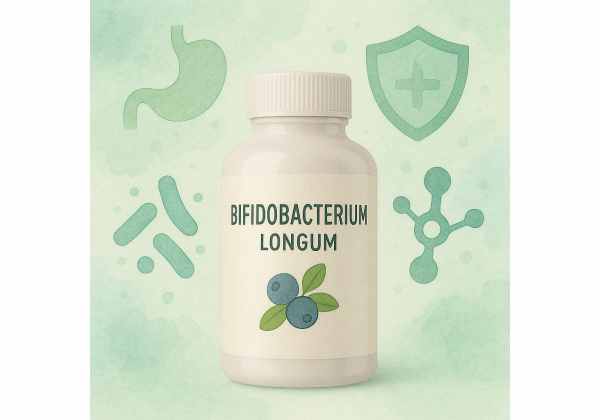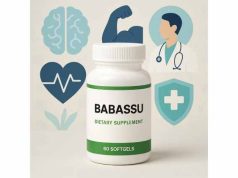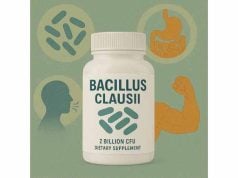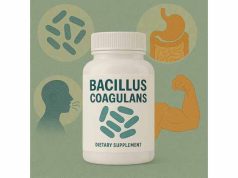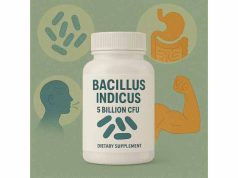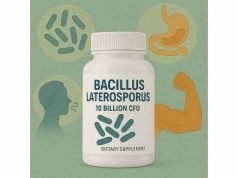Bifidobacterium longum is one of the most respected and well-researched probiotic bacteria for digestive wellness, immune support, and overall gut health. Naturally present in the human intestine from infancy through adulthood, this beneficial microbe is known for its exceptional ability to promote regularity, balance gut flora, and support resilience against everyday stressors. With unique properties that aid in the breakdown of dietary fiber and the production of critical nutrients, B. longum is often found in premium probiotic supplements and fermented foods. If you’re exploring ways to enhance digestion, reduce inflammation, or support mental well-being, learning about Bifidobacterium longum can empower you to make informed, science-backed choices for you and your family.
Key Takeaways
- Bifidobacterium longum is a powerful probiotic that supports digestion, immune function, and overall gut balance.
- Research highlights its role in reducing bloating, easing IBS symptoms, and protecting against inflammation.
- Found naturally in the human gut and in some dairy products, it thrives on dietary fiber and produces beneficial short-chain fatty acids.
- Generally safe for daily use by most ages, but those with weakened immune systems should consult a healthcare provider before supplementing.
- Effectiveness depends on the right dosage, strain identification, and product quality—always follow storage and label instructions.
Table of Contents
- Bifidobacterium longum Overview: Definition and How It Supports Human Health
- Biological Actions of B. longum: Mechanisms That Boost Gut and Immune Health
- Evidence-Based Benefits and Uses of Bifidobacterium longum in Wellness
- In-Depth Safety Guide for Bifidobacterium longum: Side Effects, Tolerability, and Interactions
- Dosage, Timing, and Best Practices for Using Bifidobacterium longum
- Bifidobacterium longum FAQs for Digestive, Immune, and Mental Health Support
Bifidobacterium longum Overview: Definition and How It Supports Human Health
Bifidobacterium longum is a species of beneficial bacteria in the Bifidobacterium genus, recognized for its critical role in maintaining gut health and bolstering the immune system. It is considered a “resident” or “commensal” microbe, meaning it naturally colonizes the human gastrointestinal tract and offers mutual benefits to both the host (you) and itself.
What Sets B. longum Apart?
- Long-Term Resident: Unlike transient bacteria, B. longum naturally resides in the colon from birth. Its levels are particularly high in breastfed infants but remain present throughout life in healthy adults.
- Dietary Fiber Champion: B. longum specializes in digesting various fibers, such as oligosaccharides (complex plant sugars), that human enzymes can’t break down. In the process, it creates valuable nutrients for the gut lining and other bacteria.
- Short-Chain Fatty Acid Production: As it digests fiber, B. longum produces short-chain fatty acids (SCFAs) like acetate and butyrate, which nourish colon cells, lower inflammation, and help maintain the integrity of the gut barrier.
Natural Sources and Forms
- Human Gut: B. longum is naturally abundant in the large intestine, especially in healthy, breastfed infants.
- Fermented Foods: While less common than other probiotic strains, B. longum is sometimes found in cultured dairy products and specialty fermented foods.
- Supplements: It is available in capsules, powders, and blends, often combined with other beneficial bacteria for a broad-spectrum probiotic effect.
How B. longum Contributes to Health
- Balances the Microbiome: B. longum helps keep harmful bacteria in check by occupying ecological niches and competing for resources in the gut.
- Supports Regular Digestion: By fermenting undigested carbohydrates, it helps regulate bowel movements and reduces bloating or discomfort.
- Immune System Modulation: B. longum interacts with immune cells in the gut, encouraging a balanced response to pathogens while promoting tolerance to non-threatening substances (like food and pollen).
- Mental Health Connections: New research links B. longum to the gut-brain axis, suggesting potential benefits for mood and stress resilience.
Who Can Benefit Most?
- Infants and Young Children: Especially after C-section births or formula feeding, supplementing with B. longum can support the development of a healthy gut microbiome.
- Adults with Digestive Issues: Those suffering from irritable bowel syndrome (IBS), mild constipation, or bloating.
- Anyone After Antibiotics: To help restore beneficial bacteria and reduce digestive upset after antibiotic use.
- Individuals Seeking Immune Support: B. longum plays a role in immune balance, making it valuable during cold/flu season or periods of stress.
Summary
Bifidobacterium longum is a versatile, science-backed probiotic that plays a foundational role in digestive, immune, and even mental health. Its ability to colonize the gut and work in harmony with the human body makes it a key ingredient in many premium probiotic supplements.
Biological Actions of B. longum: Mechanisms That Boost Gut and Immune Health
The remarkable health benefits of Bifidobacterium longum stem from its unique biological mechanisms within the human body. Unlike many “transient” probiotics that pass through the system, B. longum is adapted to survive, thrive, and work in concert with your gut and immune system.
How B. longum Survives and Functions in the Gut
- Acid and Bile Resistance: B. longum possesses protective layers and genetic adaptations that allow it to survive the acidic environment of the stomach and the presence of bile in the small intestine. This ensures that a significant number of viable cells reach the colon alive.
- Mucosal Adhesion: It can attach to the gut lining (mucosa), helping to form a protective barrier against pathogens and physically reinforce the intestinal wall.
- Prebiotic Utilization: B. longum excels at metabolizing dietary fibers, particularly oligosaccharides and resistant starches, which are otherwise indigestible by human enzymes.
Key Biological Effects
- Production of Beneficial Metabolites
- As B. longum digests fiber, it generates SCFAs such as acetate, which help:
- Nourish colonocytes (cells lining the colon)
- Reduce intestinal inflammation
- Support healthy blood sugar and cholesterol levels
- Immune System Modulation
- B. longum helps “educate” the immune system to respond to true threats while ignoring harmless stimuli (like pollen or food proteins), lowering the risk of allergies and autoimmune conditions.
- It increases the production of anti-inflammatory cytokines and supports regulatory T cells, which are vital for immune tolerance.
- Protection Against Pathogens
- By occupying binding sites on the gut lining, B. longum blocks the colonization of pathogenic bacteria, yeast, and viruses.
- It also produces natural antimicrobials that further inhibit harmful invaders.
- Enhancement of Nutrient Absorption
- B. longum breaks down otherwise inaccessible nutrients, aiding the absorption of minerals (like calcium and magnesium) and producing B vitamins essential for energy and nervous system health.
- Support for the Gut-Brain Axis
- By influencing the production of neurotransmitters and reducing systemic inflammation, B. longum may play a role in mood stability, anxiety reduction, and overall mental wellness.
Recent Scientific Insights
- Stress and Mood: Research has found that B. longum supplementation can lower stress hormones and support a calmer mood, likely through gut-brain signaling pathways.
- Allergy Reduction: Children and adults supplemented with B. longum have shown reduced rates of seasonal allergies and eczema.
- Gut Barrier Function: By strengthening the tight junctions in the intestinal lining, B. longum helps prevent “leaky gut,” which is linked to systemic inflammation.
What Influences B. longum’s Effectiveness?
- Diet: High-fiber, plant-rich diets support its growth and function.
- Antibiotic Exposure: Frequent or recent antibiotic use may reduce levels of B. longum, making supplementation especially beneficial during or after antibiotic therapy.
- Strain and Dose: Not all B. longum strains are identical—some (like B. longum BB536 or NCC3001) have unique, well-studied properties.
Summary
Bifidobacterium longum’s ability to survive, colonize, and interact with multiple body systems makes it an outstanding probiotic for comprehensive health support, from the gut to the immune system and even the mind.
Evidence-Based Benefits and Uses of Bifidobacterium longum in Wellness
The practical impact of Bifidobacterium longum on health is well-supported by modern research and clinical experience. Let’s explore the top evidence-based uses and the unique ways this probiotic can fit into your daily wellness strategy.
1. Digestive Comfort and Regularity
B. longum stands out for its proven ability to promote regular, comfortable digestion:
- Relief from Constipation: By breaking down fibers and increasing the production of SCFAs, B. longum helps regulate stool frequency and consistency.
- Reduced Bloating and Gas: It aids in the digestion of hard-to-process carbohydrates, resulting in less bloating and abdominal discomfort.
- Mild IBS Relief: Many studies have found that B. longum can ease symptoms like cramping, irregularity, and discomfort in those with irritable bowel syndrome.
2. Strengthening Immune Resilience
A large percentage of your immune system resides in your gut. B. longum supports immune health by:
- Boosting Protective Antibodies: It encourages the production of IgA and other immune factors that protect the gut lining.
- Reducing Inflammation: Its anti-inflammatory effects may lower the risk or severity of allergies, eczema, and even some autoimmune issues.
- Fighting Off Infections: Regular supplementation is linked to fewer colds, respiratory tract infections, and less time spent recovering from illness.
3. Enhancing Mental Well-Being and Stress Resilience
Emerging research connects gut bacteria with brain chemistry:
- Mood Support: Certain strains of B. longum have been shown to help reduce symptoms of anxiety and depression, likely through their effects on the gut-brain axis and inflammation reduction.
- Cognitive Benefits: By supporting gut health and lowering inflammation, B. longum may indirectly contribute to better cognitive function and sharper focus.
4. Allergy and Skin Health
- Reduction in Eczema and Dermatitis: Supplementation in infants and adults has been associated with lower rates of eczema and less skin irritation.
- Seasonal Allergy Relief: Some studies show reduced symptoms of hay fever and pollen allergies after regular B. longum use.
5. Metabolic and Cardiovascular Health
B. longum’s impact extends beyond the gut:
- Blood Sugar Regulation: By supporting SCFA production and reducing gut inflammation, B. longum may help balance blood sugar levels.
- Cholesterol Support: Some research indicates a beneficial effect on cholesterol metabolism, particularly when combined with other probiotic strains.
6. Recovery After Antibiotics or Illness
Antibiotics can deplete the gut’s natural beneficial bacteria. B. longum:
- Restores Microbiome Balance: Promotes rapid recolonization of the gut with beneficial microbes.
- Reduces Risk of Antibiotic-Associated Diarrhea: Helps prevent digestive upset and discomfort during or after antibiotic treatment.
Who Should Consider B. longum Supplementation?
- Adults or children with mild, recurring digestive complaints (bloating, constipation, mild IBS)
- Anyone recovering from illness or antibiotic use
- Those looking to support immune or mental health
- Parents seeking gentle, effective probiotics for infants or children
What to Look for in a Supplement
- Strain Identification: Products should clearly state B. longum and specific strain numbers (e.g., BB536, NCC3001).
- CFU Count: A daily dose of 1–10 billion CFU is typically effective for general wellness; higher doses may be used for targeted support.
- Quality Assurance: Choose supplements from reputable manufacturers with third-party testing and clear expiration dating.
Summary
Bifidobacterium longum is one of the most versatile probiotics available, with benefits ranging from improved digestion to stronger immunity, clearer skin, and a calmer mind. It’s a safe, gentle option for the whole family when chosen and used wisely.
In-Depth Safety Guide for Bifidobacterium longum: Side Effects, Tolerability, and Interactions
Understanding the safety and tolerability of Bifidobacterium longum is essential for anyone considering adding this probiotic to their daily routine. While B. longum is known for its gentle, non-irritating nature, it’s important to examine potential side effects, populations requiring caution, and how it interacts with other supplements or medications.
Overall Safety Profile
Bifidobacterium longum has an outstanding safety record. It’s classified as Generally Recognized as Safe (GRAS) by regulatory agencies for use in foods, infant formulas, and supplements. Clinical studies spanning all age groups—including infants, children, adults, and seniors—report minimal risk and high tolerability, even with prolonged use.
- Healthy Adults and Children: Most individuals experience no adverse effects. In fact, B. longum’s long history of use in fermented foods and supplements attests to its safety.
- Infants and Vulnerable Populations: It is widely included in infant formulas and pediatric probiotics to help establish a healthy gut microbiota from the start.
Possible Side Effects
For the vast majority of users, side effects are rare and mild, typically occurring during the first few days of use as the digestive system adjusts:
- Mild gas or bloating
- Slight abdominal discomfort
- Temporary changes in stool frequency or consistency
These effects generally resolve within a week. Starting with a lower dose and gradually increasing can help minimize adjustment symptoms. Drinking plenty of water and taking B. longum with food may also ease initial discomfort.
Who Should Use Extra Caution?
- Immunocompromised Individuals: People with severely weakened immune systems—such as those undergoing chemotherapy, recent organ transplant recipients, or individuals with advanced HIV/AIDS—should consult a healthcare provider before starting any probiotic, including B. longum. There have been rare reports of probiotics causing infections in highly vulnerable populations, though these are extremely unusual.
- Hospitalized Patients or Those with Central Lines: In very rare circumstances, probiotic bacteria (not specifically B. longum, but all probiotics) have been linked to bloodstream infections in critically ill or hospitalized patients.
- Allergy-Prone Individuals: Some probiotic supplements may contain dairy, soy, or other potential allergens. Always read product labels to avoid unwanted ingredients if you have allergies or sensitivities.
Drug and Supplement Interactions
- Antibiotics: Antibiotics can diminish the effectiveness of B. longum by killing both harmful and beneficial bacteria. It’s best to take B. longum supplements at least two hours apart from antibiotic doses to maximize their survival and benefit.
- Immunosuppressants: As with all probiotics, individuals on strong immunosuppressive medications should only use B. longum under direct medical guidance.
- Other Supplements: B. longum can be safely combined with most other probiotics and prebiotics. In fact, using B. longum in combination with other strains or with dietary fiber (prebiotics) can enhance its benefits.
Long-Term Use and Safety
B. longum is suitable for long-term daily use. No significant risks have been reported with ongoing supplementation in healthy individuals, and research supports its continued role in maintaining digestive and immune health.
How to Monitor for Adverse Reactions
While severe side effects are exceptionally rare, stop using the supplement and consult your healthcare provider if you experience:
- Persistent or worsening digestive symptoms
- Severe abdominal pain
- Signs of an allergic reaction (such as hives, rash, swelling)
- High fever or signs of infection (particularly if immunocompromised)
Safety Table: Quick Reference
| Group | Safety Profile | Recommendations |
|---|---|---|
| Healthy adults/children | Excellent | Follow recommended dosing |
| Infants (with pediatrician) | Excellent | Use pediatric-specific formulations |
| Immunocompromised | Caution—medical guidance | Consult healthcare provider |
| Antibiotic users | Safe—space dosing | 2+ hours after antibiotics |
| Pregnant/Breastfeeding | Generally safe | Seek advice if uncertain |
| Allergy-prone | Safe—read labels | Avoid allergens in supplement |
Summary
For most people, Bifidobacterium longum is a highly safe, gentle, and effective probiotic. Those with unique health conditions should seek professional guidance, but the risk of serious adverse effects is extremely low. Selecting high-quality, clearly labeled supplements maximizes benefits and minimizes any potential risk.
Dosage, Timing, and Best Practices for Using Bifidobacterium longum
Achieving the full benefits of Bifidobacterium longum comes down to correct dosage, smart timing, and choosing the right product for your needs. Since probiotics are only effective if enough live bacteria reach the gut, following best practices is crucial.
Recommended Dosages for Different Age Groups
- Adults: Most clinical studies support doses between 1 and 10 billion CFU (colony-forming units) per day. Some supplements provide higher doses, especially for targeted digestive relief or after antibiotics.
- Children: Pediatric probiotic products with B. longum often supply 1 to 5 billion CFU per day in chewable, powder, or drop form.
- Infants: For babies, especially those recovering from C-section, formula feeding, or antibiotics, supplements may provide 100 million to 1 billion CFU daily. Always use products formulated for infants and seek pediatric advice if uncertain.
How to Take Bifidobacterium longum
- With or Without Food: Most supplements can be taken with or without food. However, taking probiotics with a light meal may increase their survival through the acidic stomach environment.
- Time of Day: The most important factor is consistency. Take your probiotic at the same time each day—morning or night is fine, as long as it becomes part of your routine.
- After Antibiotics: If you’re using B. longum to restore gut balance after antibiotics, take it at least two hours after your medication to maximize effectiveness.
Forms and Formulations
- Capsules/Tablets: Convenient for adults and older children; look for enteric-coated varieties that help bacteria survive stomach acid.
- Powders/Drops: Ideal for children and infants; can be mixed into milk, formula, or food.
- Combination Products: B. longum is often paired with other beneficial bacteria (like Lactobacillus species) and prebiotics for a synergistic effect.
Storage and Potency
- Refrigeration: Some B. longum supplements require refrigeration to maintain potency. Always check product labels for storage instructions.
- Shelf-Stable Options: Advances in probiotic technology mean some products are stable at room temperature, making them easier to travel with and store.
Supporting Probiotic Success
- Dietary Fiber: Eat a fiber-rich diet with plenty of fruits, vegetables, whole grains, and legumes. These foods provide prebiotics, which help B. longum flourish.
- Hydration: Drink adequate water to support digestive function and probiotic activity.
- Lifestyle: Regular physical activity and stress management help create an environment in which probiotics can thrive.
Adjusting Dosage
- Start Low: If you’re new to probiotics, begin with a lower dose and increase gradually to minimize digestive adjustment.
- Monitor Response: Most people see digestive benefits within one to two weeks. If you experience ongoing discomfort, consult a healthcare provider or try a different strain or brand.
Signs of Effectiveness
- Improved regularity and stool consistency
- Less bloating or abdominal discomfort
- Better immune resilience (fewer colds, faster recovery)
Dosage and Use Table
| Group | Typical Daily Dose | Form | Key Notes |
|---|---|---|---|
| Adults | 1–10 billion CFU | Capsule, powder | For maintenance or symptom relief |
| Children | 1–5 billion CFU | Chewable, powder | Age-appropriate products |
| Infants | 100 million–1 billion CFU | Drops, powder | Pediatric-specific, under medical guidance |
| After antibiotics | 10–20 billion CFU (short-term) | Capsule, powder | Then revert to maintenance dose |
Choosing a High-Quality Supplement
- Select products from reputable manufacturers with third-party testing.
- Look for clear strain identification (e.g., B. longum BB536).
- Ensure the product guarantees potency through the expiry date.
Summary
Daily, consistent use of Bifidobacterium longum at appropriate dosages yields the greatest digestive, immune, and overall wellness benefits. Quality, storage, and dietary habits all influence your probiotic success—choose wisely and be patient for optimal results.
Bifidobacterium longum FAQs for Digestive, Immune, and Mental Health Support
What is Bifidobacterium longum used for?
Bifidobacterium longum is used to promote digestive regularity, reduce bloating, support immune resilience, help restore gut balance after antibiotics, and may also support mental wellness via the gut-brain axis.
Is Bifidobacterium longum safe for daily use?
Yes, B. longum is safe for most adults, children, and infants. Those with weakened immune systems or serious illnesses should consult a healthcare professional before use.
How soon will I see benefits from Bifidobacterium longum?
Most people notice improvements in digestion within one to two weeks. Immune and mood support benefits may develop with regular, ongoing use.
Can infants and children take Bifidobacterium longum supplements?
Yes, B. longum is included in many pediatric probiotic products and infant formulas. Always choose age-appropriate products and consult your pediatrician if you have questions.
Should Bifidobacterium longum be taken with food or on an empty stomach?
Most supplements can be taken with or without food. Taking with food may help more bacteria survive stomach acid; always follow the label instructions.
Does Bifidobacterium longum interact with antibiotics or medications?
It is safe to use alongside antibiotics but should be taken at least two hours apart. It has no significant interactions with common medications, but check with your doctor if taking immunosuppressants.
Are there any long-term risks with Bifidobacterium longum?
No significant long-term risks have been reported for healthy users. For those with chronic health issues, consult your healthcare provider before starting any new supplement.
Disclaimer:
This content is for educational purposes only and is not intended as a substitute for medical advice, diagnosis, or treatment. Always consult your healthcare provider before starting any supplement, especially if you have health concerns or are pregnant, breastfeeding, or taking medication.
If you found this guide helpful, please share it with friends or on your favorite social media platforms such as Facebook or X (formerly Twitter), and follow us for more science-backed wellness articles. Your support helps us continue to deliver trusted, high-quality health information!


